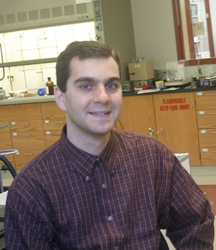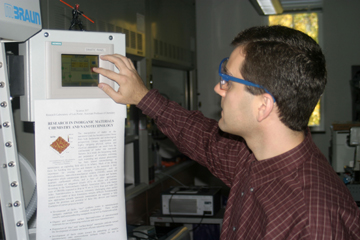 Lon Porter |
“I was in the honors college there, which was like a small school in the middle of a larger university, so I really got used to walking in and chatting with professors, even if it wasn’t about a course,” the first-year Wabash professor says. “Some people are afraid to use the word ‘friend’ when describing student/teacher relationships, but it was something close to that.”
Porter has embraced the chemistry department’s team-teaching approach and the faculty’s commitment to mentoring at this liberal arts college for men, where student responses to the Princeton Review ranked Wabash eighth nationally in the category “professors are accessible to students” and 20th in “professors bring material to life.”
“My wife and I moved to a house on Main Street in Crawfordsville—we wanted to be close so we could be part of the community,” Porter says. “We missed that sense of community during my graduate years at Purdue, and we love it here. It’s so nice to walk over to a play or event or to stop by and talk to guys sitting out at the frat houses. Students here respond very well to genuine interest in what’s going on.
“Our new science building is a community, as well,” Porter says, and he spends a lot of time after class in the newly dedicated $30 million facility housing the biology and chemistry departments.
You get a sense of Porter’s enthusiasm for his new learning community when he refers to “chapel sing”—one of the College’s freshman initiation rites—to illustrate the chemical principle behind his upcoming research.
 |
“At Purdue we found a way to put organic molecules on silicon, to make features on silicon film that were at the nano-scopic level—features 1,000 times smaller than the width of a human hair,” Porter explains. This makes possible the development of silicon chips similar to those found in computers that can be implanted in humans to detect biohazards such as bacteria, nerve gas or other chemical agents.
“That’s cool in its own right, but it’s time to kick it up to the next level,” Porter says. With the Dreyfus Grant and working with Wabash students, Porter plans to develop a new and versatile toolkit for nanotechnology.
“There’s a toolkit for organic chemistry—the organic chemistry book— but there isn’t a toolkit for building things on these surfaces, and that’s what we plan to develop.”
Porter and his students will make a two-nanometer-diameter piece of gold from gold salt solution and attach organic molecules to it.
“Scientists have done this, but nothing industrially or commercially viable has come from it, because most industrial reactions are really hot, and when you heat these things, they decompose.”
That’s where Porter’s method—and the “chapel sing” analogy—come in. “We’re going to use some organic chemistry to bind the molecules not just to the gold, but to each other in a polymer to make an organic shell,” Porter explains. “Just like chapel sing, where the guys interlock arms so they can’t be pulled apart.”
“Once we can do this, we’ll be able to attach groups well known in the organic chemistry literature for all sorts of applications,” Porter says, noting particular uses as catalysts in the pharmaceutical industry and other medical applications.
The benefits to students will be immediate.
“They’ll learn many techniques and gain knowledge that they wouldn’t get in a traditional inorganic research lab,” Porter says. “We’ll make the metal clusters, which is inorganic chemistry; then we’ll make the molecules, which is organic; and then we’ll put them together and look at the properties, which is physical chemistry. We’ll characterize them and then see the application firsthand.”
Porter will also bring his expertise in nanotechnology to a broader audience this spring when he teaches an entry-level course on the subject.
“The course will be open to everyone across campus, and that’s important,” Porter explains. “People call nanotechnology the next industrial revolution, and we need to consider the science in that from a liberal arts point of view.
“Our students need to be knowledgeable about this, or others will take advantage of our ignorance in this field,” Porter says. He cites a recent TV clothing commercial claiming stainguard provided by nanotechnology.
“I joke and tell students that ‘nanotechnology is everywhere, even in your pants,” Porter quips. “But the add isn’t true—it’s not really nanotechnology, they’re just using the buzzword to try and fool you,”
Such deceit will inevitably arise in much more serious situations.
“We need to be smart about this,” Porter says, seeing science education at this level as an integral part of the liberal arts curriculum in the 21st century.
“This is part of being a Wabash man, a liberally educated man, and an intelligent interactor with the world around you.”